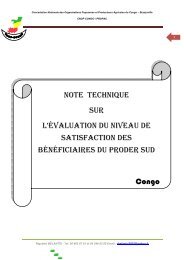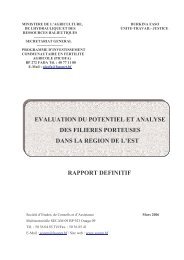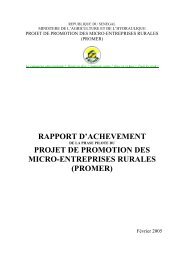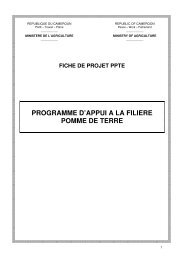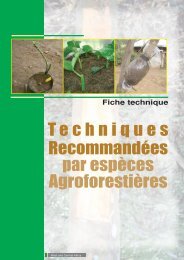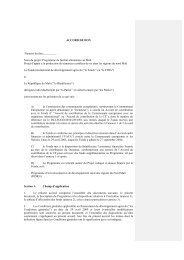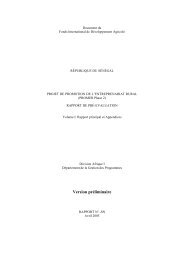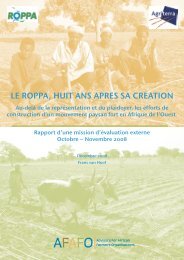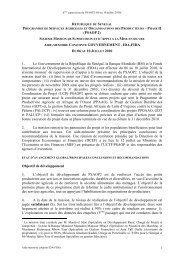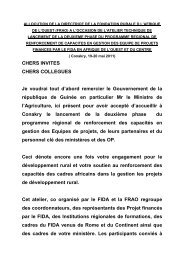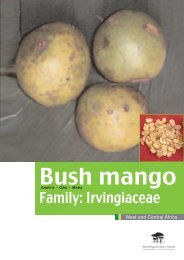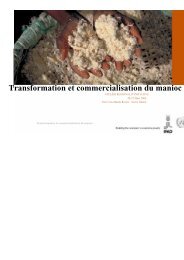Scaling Up the Fight Against Rural Poverty - FIDAfrique
Scaling Up the Fight Against Rural Poverty - FIDAfrique
Scaling Up the Fight Against Rural Poverty - FIDAfrique
You also want an ePaper? Increase the reach of your titles
YUMPU automatically turns print PDFs into web optimized ePapers that Google loves.
approval of IFAD projects in which value chains were ei<strong>the</strong>r components or <strong>the</strong> primary instruments<br />
for poverty alleviation increased from 1.8 per cent in 2005 to 50 per cent last year.” 20<br />
IFAD is currently completing a <strong>the</strong>matic study of <strong>the</strong> development of value chains as a way to assist<br />
<strong>the</strong> rural poor. Based on a number of case studies it develops a thorough understanding of <strong>the</strong> value<br />
chain concept, reviews some of <strong>the</strong> experiences to date, analyzes <strong>the</strong> potential and constraints of <strong>the</strong><br />
value chain approach and draws conclusions for IFAD’s operational engagement in value chain<br />
development. The study does not specifically focus on <strong>the</strong> opportunities and challenges of scaling up<br />
with value chains, but some of <strong>the</strong> conclusions are of relevance here. First, <strong>the</strong> study identifies three<br />
key factors for successful pro-poor value chain development: (a) achievement of higher farm-gate<br />
prices; (b) development of strong and inclusive farmer organizations; and (c) outreach to rural women<br />
and <strong>the</strong> rural poor. Second, <strong>the</strong> study stresses <strong>the</strong> important role of <strong>the</strong> enabling environment (in terms<br />
of policies, regulation, and broadly <strong>the</strong> investment climate) and of effective private-public<br />
partnerships. Third, <strong>the</strong> development of appropriate financing mechanisms is a critical element to<br />
successful pro-poor value-chain development. All three factors will likely play and important role if<br />
IFAD wishes to scale up its value chain interventions so as to reach a broader range of poor rural<br />
beneficiaries.<br />
IFAD has various interesting examples of successful scaled-up value chain programs, among <strong>the</strong>m<br />
some going back 20-30 years. A case in point is IFAD’s engagement in support of a broad-gauged<br />
approach to cassava development in Africa. 21 Ano<strong>the</strong>r example of a successful value chain program,<br />
albeit more limited, is <strong>the</strong> case of “PhytoTrade Africa”, a membership-based company in South Africa<br />
which has aimed to develop, with IFAD support, “a sustainable natural products industry in sou<strong>the</strong>rn<br />
Africa that will be of benefit both to people and to biodiversity” (IFAD 2009a, p. 42). It involved “<strong>the</strong><br />
creation of new value chains from tree products in arid zones, including beverages, cosmetic oils and<br />
health-care products in eight countries in eastern and sou<strong>the</strong>rn Africa.” (ibid.) A third example in<br />
which IFAD was concerned with <strong>the</strong> scaling up of a value chain approach, involved a <strong>the</strong>matic<br />
evaluation of organic agriculture and poverty reduction in Asia, which in effect took a value-chain<br />
approach to <strong>the</strong> question how organic agriculture could be developed in Asia. (IFAD Office of<br />
Evaluation, 2005).<br />
However, according to recent evaluations, <strong>the</strong> effectiveness of IFAD’s value chain interventions<br />
remains a concern. The ARRI 2009 credits IFAD with incorporating more value chain elements into<br />
its programs, but it also concludes “that constraints to improving market access are enormous and<br />
<strong>the</strong>re are no easy solutions.” (IFAD Independent Office of Evaluation, 2009d, p. 10). The 2009<br />
Portfolio Review similarly gives IFAD credit for having given more attention to value chain aspects in<br />
<strong>the</strong> programs which it supports, but it concludes that <strong>the</strong> area of market access remains one of <strong>the</strong><br />
weakest in terms of IFAD’s effectiveness. (IFAD, 2009c, p. 14). The recent Country Program<br />
Evaluations for India and Nigeria also conclude that IFAD’s engagement in support of value chains<br />
needs improvement. (IFAD Office of Evaluation 2009 A, B)<br />
In short, <strong>the</strong> value chain approach holds great promise for establishing a pathway towards scaling up.<br />
20 http:/www.ifad.org/events/op/2010/unido.htm<br />
21 Cheikh Sourang summarized IFAD’s experience of <strong>the</strong> 1980s and 1990s in his Key Note Address at <strong>the</strong><br />
“Validation Forum on <strong>the</strong> Global Cassava Development Strategy (GCDS)” held in Rome on 26-28 April 2000,<br />
under <strong>the</strong> heading of “<strong>Scaling</strong> up <strong>the</strong> implementation of GCDS”. See FAO/IFAD (2001). p. 50. Based on <strong>the</strong><br />
experience of <strong>the</strong> 1980s and 1990s <strong>the</strong> Global Cassava Development Strategy was developed by a multistakeholder<br />
alliance in 2000 (including IFAD, FAO, CIAT, IITA, CIRAD and NRI), with a view to laying<br />
ground to fur<strong>the</strong>r scale up <strong>the</strong> development of <strong>the</strong> cassava value chain. Unfortunately, it appears that <strong>the</strong><br />
strategy has not been systematically implemented since.<br />
25



